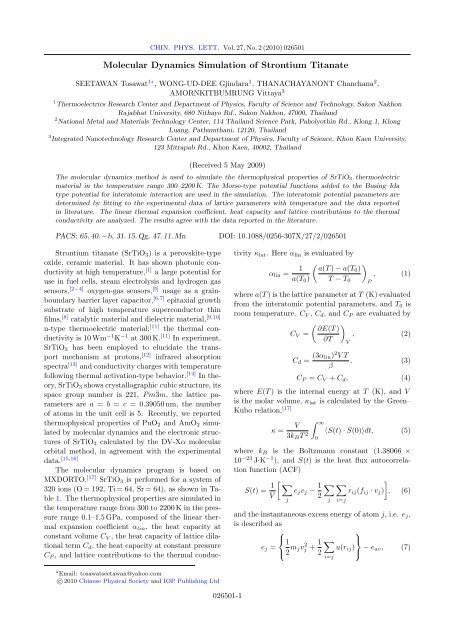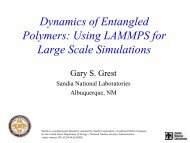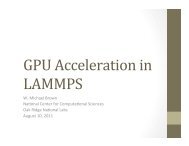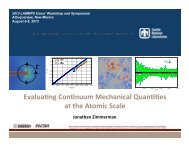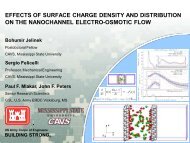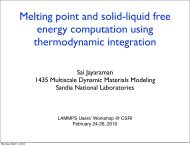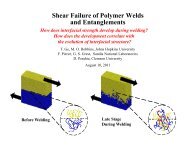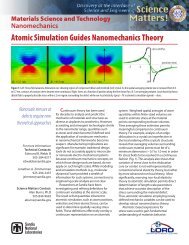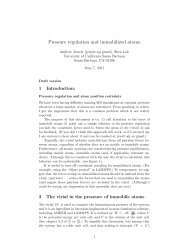Molecular Dynamics Simulation of Strontium Titanate - Lammps
Molecular Dynamics Simulation of Strontium Titanate - Lammps
Molecular Dynamics Simulation of Strontium Titanate - Lammps
You also want an ePaper? Increase the reach of your titles
YUMPU automatically turns print PDFs into web optimized ePapers that Google loves.
CHIN. PHYS. LETT. Vol. 27, No. 2 (2010) 026501<br />
<strong>Molecular</strong> <strong>Dynamics</strong> <strong>Simulation</strong> <strong>of</strong> <strong>Strontium</strong> <strong>Titanate</strong><br />
SEETAWAN Tosawat 1* , WONG-UD-DEE Gjindara 1 , THANACHAYANONT Chanchana 2 ,<br />
AMORNKITBUMRUNG Vittaya 3<br />
1 Thermoelectrics Research Center and Department <strong>of</strong> Physics, Faculty <strong>of</strong> Science and Technology, Sakon Nakhon<br />
Rajabhat University, 680 Nithayo Rd., Sakon Nakhon, 47000, Thailand<br />
2 National Metal and Materials Technology Center, 114 Thailand Science Park, Paholyothin Rd., Klong 1, Klong<br />
Luang, Pathumthani, 12120, Thailand<br />
3 Integrated Nanotechnology Research Center and Department <strong>of</strong> Physics, Faculty <strong>of</strong> Science, Khon Kaen University,<br />
123 Mitrapab Rd., Khon Kaen, 40002, Thailand<br />
(Received 5 May 2009)<br />
The molecular dynamics method is used to simulate the thermophysical properties <strong>of</strong> SrTiO 3 thermoelectric<br />
material in the temperature range 300–2200 K. The Morse-type potential functions added to the Busing–Ida<br />
type potential for interatomic interaction are used in the simulation. The interatomic potential parameters are<br />
determined by fitting to the experimental data <strong>of</strong> lattice parameters with temperature and the data reported<br />
in literature. The linear thermal expansion coefficient, heat capacity and lattice contributions to the thermal<br />
conductivity are analyzed. The results agree with the data reported in the literature.<br />
PACS: 65. 40. −b, 31. 15. Qg, 47. 11. Mn<br />
DOI: 10.1088/0256-307X/27/2/026501<br />
<strong>Strontium</strong> titanate (SrTiO 3 ) is a perovskite-type<br />
oxide, ceramic material. It has shown photonic conductivity<br />
at high temperature, [1] a large potential for<br />
use in fuel cells, steam electrolysis and hydrogen gas<br />
sensors, [2−4] oxygen-gas sensors, [5] usage as a grainboundary<br />
barrier layer capacitor, [6,7] epitaxial growth<br />
substrate <strong>of</strong> high temperature superconductor thin<br />
films, [8] catalytic material and dielectric material, [9,10]<br />
n-type thermoelectric material; [11] the thermal conductivity<br />
is 10 Wm −1 K −1 at 300 K. [11] In experiment,<br />
SrTiO 3 has been employed to elucidate the transport<br />
mechanism at protons, [12] infrared absorption<br />
spectra [13] and conductivity charges with temperature<br />
following thermal activation-type behavior. [14] In theory,<br />
SrTiO 3 shows crystallographic cubic structure, its<br />
space group number is 221, P m¯3m, the lattice parameters<br />
are a = b = c = 0.39050 nm, the number<br />
<strong>of</strong> atoms in the unit cell is 5. Recently, we reported<br />
thermophysical properties <strong>of</strong> PuO 2 and AmO 2 simulated<br />
by molecular dynamics and the electronic structures<br />
<strong>of</strong> SrTiO 3 calculated by the DV-Xα molecular<br />
orbital method, in agreement with the experimental<br />
data. [15,16]<br />
The molecular dynamics program is based on<br />
MXDORTO, [17] SrTiO 3 is performed for a system <strong>of</strong><br />
320 ions (O = 192, Ti = 64, Sr = 64), as shown in Table<br />
1. The thermophysical properties are simulated in<br />
the temperature range from 300 to 2200 K in the pressure<br />
range 0.1–1.5 GPa, composed <strong>of</strong> the linear thermal<br />
expansion coefficient α lin , the heat capacity at<br />
constant volume C V , the heat capacity <strong>of</strong> lattice dilational<br />
term C d , the heat capacity at constant pressure<br />
C P , and lattice contributions to the thermal conductivity<br />
κ lat . Here α lin is evaluated by<br />
α lin = 1 (︂ a(T ) − a(T0 )<br />
, (1)<br />
a(T 0 ) T − T 0<br />
)︂P<br />
where a(T ) is the lattice parameter at T (K) evaluated<br />
from the interatomic potential parameters, and T 0 is<br />
room temperature. C V , C d , and C P are evaluated by<br />
(︂ )︂ ∂∂E(T )<br />
C V =<br />
, (2)<br />
∂∂T<br />
C d = (3α lin) 2 V T<br />
β<br />
V<br />
, (3)<br />
C P = C V + C d , (4)<br />
where E(T ) is the internal energy at T (K), and V<br />
is the molar volume, κ lat is calculated by the Green–<br />
Kubo relation, [17]<br />
κ =<br />
V ∫︁ ∞<br />
3k B T 2 ⟨S(t) · S(0)⟩dt, (5)<br />
0<br />
where k B is the Boltzmann constant (1.38066 ×<br />
10 −23 J·K −1 ), and S(t) is the heat flux autocorrelation<br />
function (ACF)<br />
S(t) = 1 [︂ ∑︁<br />
e j v j − 1 ∑︁ ∑︁<br />
]︂<br />
r ij (f ij · v j ) , (6)<br />
V<br />
2<br />
j<br />
j i=j<br />
and the instantaneous excess energy <strong>of</strong> atom j, i.e. e j ,<br />
is described as<br />
⎧<br />
⎫<br />
⎨<br />
1<br />
e j =<br />
⎩2 m jvj 2 + 1 ∑︁ ⎬<br />
u(r ij )<br />
2 ⎭ − e av, (7)<br />
i=j<br />
* Email: tosawatseetawan@yahoo.com<br />
c○ 2010 Chinese Physical Society and IOP Publishing Ltd<br />
026501-1


